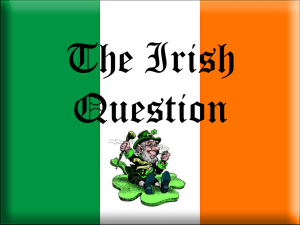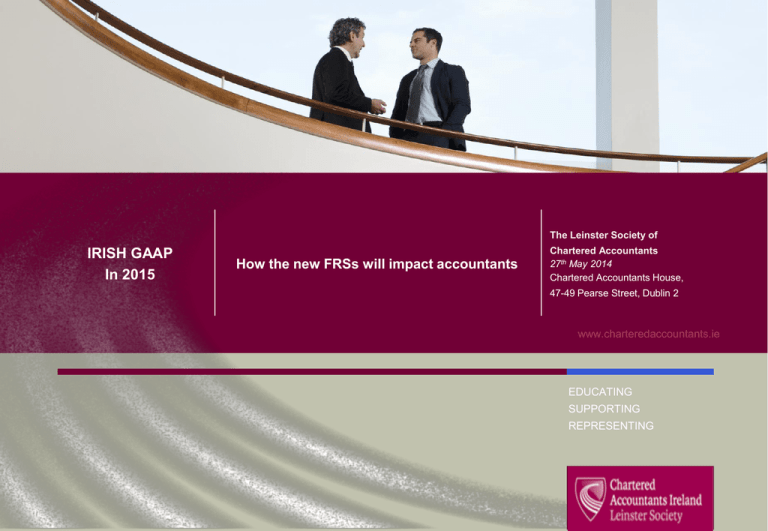
The Leinster Society of
IRISH GAAP
In 2015
How the new FRSs will impact accountants
Chartered Accountants
27th May 2014
Chartered Accountants House,
47-49 Pearse Street, Dublin 2
www.charteredaccountants.ie
EDUCATING
SUPPORTING
REPRESENTING
Speakers
Deloitte’s
• Oliver Holt Director of Financial Reporting
Grant Thornton’s
• Fergus Condon Financial Accounting and Advisory Services Partner and
• Peter Vale Tax partner
Agenda
• Introduction
• FRS 101
• FRS 102:
o General purpose accounting
o Financial instruments accounting
o Tax implications
• Q&A and close
Irish GAAP in 2015
How the new FRSs will impact accountants
Oliver Holt
Director of Financial Reporting
Deloitte & Touche
27 May 2014
Leinster Society of Chartered Accountants
Chartered Accountants House, Dublin 2
© 2014 Deloitte & Touche
The GAAPs on offer – a menu of choice
5
© 2014 Deloitte & Touche
Irish GAAP 2015 in a nutshell….
FRS 100
• ‘Application of financial reporting requirements’
• Which standard to apply; application of SORPs; Statement of compliance;
effective date; meaning of ‘equivalence’
FRS 101
• ‘Reduced disclosure framework’
• List of disclosure exemptions from full IFRSs for ‘qualifying entities’
FRS 102
• ‘The Financial Reporting Standard applicable in the UK and Republic of Ireland’
• Operational FRS derived from the IFRS for SMEs; list of disclosure exemptions
from this FRS for ‘qualifying entities’
FRS 103
• ‘Insurance Contracts’
• applicable to entities reporting under FRS 102 that have insurance contracts
(including reinsurance contracts) and/or issue financial instruments with a
discretionary participation feature.
Other
6
• Foreword; FRC Abstracts; SORPs and FRSSE
© 2014 Deloitte & Touche
FRS 100 – who does what?
Currently applying;
Proposed:
Reduced disclosures?
Required to apply EU
adopted IFRS
No change
No
Opted to apply IFRS
Option:
IFRS (no change), or
FRS 102
Yes, for parent or
subsidiaries
Irish FRS
Option:
IFRS, or
FRS 102
Yes, for parent or
subsidiaries
FRSSE
No change (but FRSSE to
be further simplified)
N/a
(i.e. Listed group)
7
© 2014 Deloitte & Touche
The GAAPs on offer – decision-making time
•
FRSs 100-103 effective for periods beginning on/after 1 January 2015
•
Early adoption permitted: for FRS 102 – December 2012 onwards
•
Transition to IFRSs possible at any stage
•
Expect further consultation on the FRSSE
•
Timeline for a calendar year end reporter:
FRSs
100-101
Today,
you are here!
FRS 102
2012
2013
Early adoption
permitted
8
FRS 103
2014
1 January 2014
date of
transition
2015
31 December 2014
comparative
balance sheet
31 December 2015
first year-end
balance sheet
© 2014 Deloitte & Touche
Introducing FRS 101
‘Reduced Disclosure Framework’
9
© 2014 Deloitte & Touche
What is FRS 101 exactly?
FRS 101 financial statements are…
Prepared using IFRS recognition and
measurement bases
Technically Companies Act accounts
(therefore must comply with company law)
Granted a number of disclosure
exemptions
FRS
101
Financial
statements
Available to “qualifying entities” in
individual financial statements only
10
© 2014 Deloitte & Touche
Who is eligible to apply FRS 101?
A qualifying entity is…
•
A member of a group where the parent prepares publicly available consolidated financial
statements which are intended to give a ‘true and fair’ view and include equivalent
disclosures at group level
•
Included in those consolidated accounts
•
Shareholders must have been notified in writing - objection thresholds (5% of total or
50% of the minority)
•
Entity must make certain disclosures in its financial statements - compliance note;
exemptions taken
What does this mean in practice?
Most parents and
subsidiaries will be
qualifying entities
11
No explicit
requirement for the
consolidated
accounts to be
prepared under IFRS
Disclosure reductions
are
available in separate
(company only)
financial statements
© 2014 Deloitte & Touche
FRS 101 accounts are Companies Act accounts
What does this mean?
Companies Act
formats for
primary statements
Negative goodwill
on balance sheet
Goodwill impairment
shall be reversed if
conditions reverse
Grant accounting –
netting off prohibited
12
Companies Act
required disclosures
FRS 101 and the
Companies Act
Discontinued
operations must be on
face of P&L
Not permitted to fair
value earn-outs
© 2014 Deloitte & Touche
What are the disclosure reductions?
As specified by FRS 101
Not currently required in Irish
Disclosed on a group basis
Other
• Cash flow statement & notes (IAS 7)
• Key management compensation (IAS 24)
•
•
•
•
•
Share-based payments (IFRS 2)
Financial instruments (IFRS 7)†
Fair values (IFRS 13)†
Acquisitions (IFRS 3)
Cashflows from discontinued operations (IFRS
5)
• Impairment (IAS 36)
•
•
•
•
•
Comparative data (IAS 16, 38, 40)
Third balance sheet (IAS 1)
Capital management (IAS 1)†
Standards not yet applied (IAS 8)
Group related party transactions (IAS 24)
† No exemption for financial institutions
13
© 2014 Deloitte & Touche
What about financial institutions?
Financial institutions can be qualifying entities, but may not take all of the
exemptions provided by FRS 101.
The Glossary to FRS 100 gives a long list of entities which are financial institutions,
including:
• Banks, building societies, credit unions, custodian banks, broker-dealers, stock-brokers,
insurance entities, friendly societies, investment trusts, VC trusts, unit trusts, open-ended
investment companies and retirement benefit plans
There is also a relatively broad 'catch-all' which may be tougher to apply in
practice:
“A financial institution is…any other entity whose principal activity is to generate
wealth or manage risk through financial instruments. This is intended to cover
entities that have business activities similar to those listed above but are not
specifically included in the list above.
A parent entity whose sole activity is to hold investments in other group entities is not
a financial institution.”
14
© 2014 Deloitte & Touche
FRS 101 – characteristics and implications
Key characteristics of IFRSs/FRS 101
•
Greater use of fair value as a measurement basis, increasing focus on obtaining
reliable results
•
FRS 101 provides a reduced disclosure regime for some qualifying group companies –
but new complexity of interaction with the Companies Acts.
Key implications
•
More complexity than Irish GAAP in recognition, measurement and disclosure
•
International comparability
•
Ease of group reporting
•
More changes from Irish GAAP and therefore potentially more significant tax impacts
15
© 2014 Deloitte & Touche
FRS 101 – to adopt or not to adopt?
More than accounting
Impact on
tax/gearing
compensation
Cost of
Conversion
Current
group
framework/s
- compatible?
Things to
think about…
- minimise?
Distributable profits
- decreased?
16
Early adoption
- beneficial?
Disclosure
reductions
- permission?
Companies Acts
formats
- significant
complexities?
iXBRL
- affected?
© 2014 Deloitte & Touche
Leinster Society of Chartered
Accounts
FRS 102
May 2014
Fergus Condon
Partner
Grant Thornton
© 2014 Grant Thornton Ireland. All rights reserved
Peter Vale
Partner
Grant Thornton
FRS 102 – its origins.
• Based largely on IFRS for SMEs but with numerous differences
• 35 sections grouped by topic
• Glossary of defined terms
• Not a 'one-stop shop' –
– still need to meet statutory requirements too
– cross reference to IFRS in some instances
– full IFRS for EPS, segment reporting and extractive industries
• 'PBE' prefix for paragraphs specific to public benefit entities
© 2014 Grant Thornton Ireland. All rights reserved.
18
FRS 102 – Heat Map
Defined benefit pensions
Revenue recognition /
High
Impact on
Financial
Statements
Inter-company
Fixed assets
Financial Instruments
Deferred Tax
Investment property
Leases
Foreign currency
Cash
Presentation of financial
statements
Impairment Review
Low
Medium
High
Medium
Low
Impact on process /systems
© 2014 Grant Thornton Ireland. All rights reserved.
19
Business combinations/
goodwill
Transition requirements
© 2014 Grant Thornton Ireland. All rights reserved
Summary of transition requirement
• statement of compliance to be included
• full comparatives presented (opening balance sheet not required)
• retrospective accounting except for certain areas
– de-recognition of financial assets and financial liabilities
– hedge accounting
– accounting estimates
– discontinued operations
– measuring non-controlling interests
• certain exemptions available which will be highlighted in sections
below.
© 2014 Grant Thornton Ireland. All rights reserved.
21
Summary of transition considerations
• explain how transition affected reported financial position and
performance by:
– nature of change in accounting policy
– reconciliation of equity from one framework to the other at date
of transition and end of period
– reconciliation of profit/loss from one framework to the other at
the end of the period.
© 2014 Grant Thornton Ireland. All rights reserved.
22
FRS 102 – Areas requiring
most consideration
© 2014 Grant Thornton Ireland. All rights reserved
Employee benefits – key differences – compensated
absences
Current Irish GAAP:
FRS 17: Retirement
benefits
•
FRS 102:
Section 28: Employee
Benefits
• If an entity compensates employees
for absences for various reasons(eg
annual leave), and if these
accumulate, then an entity shall
recognise the expected cost of
these absences when the
employees renders the service.
• HR systems should be assessed to
ensure capabilities for capturing
necessary information.
no requirement to accrue for
compensated absences such as
sick leave
© 2014 Grant Thornton Ireland. All rights reserved.
24
Employee benefits – key differences – group defined
benefit schemes
Current Irish GAAP
FRS 102
• group scheme = multi-employer
scheme
• group scheme ≠ multi-employer
scheme
• group DB schemes can be offbalance sheet for all group
entities (except consolidated
accounts), all companies
account for scheme as DC
• group DB schemes either
entirely on legally responsible
employer or accounting follows
stated policy or contractual
agreement.
© 2014 Grant Thornton Ireland. All rights reserved.
25
Employee benefits – key differences –
multi-employer schemes
Current Irish GAAP
FRS 102
• can be accounted for as though
it were a defined contribution
arrangement provided the
employer is unable to identify its
share of the underlying assets
and liabilities in the scheme on
a consistent and reasonable
basis
• can also be accounted for as a
DC scheme but there is also an
additional requirement to
recognise a liability for any
funding arrangement that has
been agreed with the pension
scheme.
© 2014 Grant Thornton Ireland. All rights reserved.
26
Employee benefits – key differences –
defined benefit schemes
Current Irish GAAP
•
the cost relating to movements in
the net liability is recognised in P&L
aside from actuarial gains/losses
which are recognised in the STRGL
•
an expected return on plan assets
is recognised as income in the P&L
and the interest cost relating to
scheme liabilities is recognised
separately as an expense
© 2014 Grant Thornton Ireland. All rights reserved.
FRS 102
27
•
cost relating to movements in the
net liability is recognised in P&L
except for the effects of
re-measurement which are
recognised in OCI
•
re-measurement comprises
actuarial gains/losses and the
return on plan assets, excluding
amounts included in net interest on
the net liability.
Employee benefits – key differences –
defined benefit schemes continued
Current Irish GAAP
•
the net surplus/deficit (net of
deferred tax) is presented on the
balance sheet after other net assets
•
no requirement to obtain a full
actuarial valuation (by a
professionally qualified actuary) at
each balance sheet date.
© 2014 Grant Thornton Ireland. All rights reserved.
FRS 102
28
•
deferred tax not netted against the
net surplus/deficit but shown
separately as part of the remaining
deferred tax balance
•
no requirement to use an
independent actuary to perform the
actuarial valuation and no
requirement to perform a
comprehensive actuarial valuation
annually.
Revenue – reference comparison and key differences
Current Irish GAAP
FRS 102
• FRS 5 application note G
– principles similar to
IAS 18
– looks more from point of
view of asset/liability
recognition
© 2014 Grant Thornton Ireland. All rights reserved.
• Section 23 - derived from IAS
18
• mostly similar to Irish GAAP
but…
– look at the detail
– benchmark existing policies
against FRS 102
requirements
– do not take it for granted
they will be the same.
29
Business Combinations - Key differences: intangible
assets acquired
FRS 102
Current Irish GAAP
• recognise intangible asset
separately from goodwill if:
– identifiable
– can be measured reliably
• identifiable includes being able
to dispose of asset separately
© 2014 Grant Thornton Ireland. All rights reserved.
• recognise intangible asset
separately from goodwill if:
– identifiable
– can be measured reliably
• identifiable means separable or
arising from contractual or legal
rights
• fair value can normally be
measured reliably.
30
Business Combinations – Key differences: amortisation of
goodwill and intangible assets
FRS 102
Current Irish GAAP
• if life is finite, amortise over life
• rebuttable presumption that
useful life does not exceed 20
years
• if life is indefinite:
– do not amortise
– test for impairment annually
© 2014 Grant Thornton Ireland. All rights reserved.
• life is always finite
• amortise over useful life
• life limited to five years if
unable to make reliable
estimate of life.
31
Investment properties – key differences
Current Irish GAAP:
SSAP 19: Accounting for
investment properties
•
•
•
•
FRS 102: Section 16: Investment
property
•
•
revalue to open market value
movements to STRGL
property must be complete before
being recognised as an investment
property
property let to another group company
is specifically excluded from the
definition of an investment property
•
•
•
•
© 2014 Grant Thornton Ireland. All rights reserved.
32
definition differences
fair value at each reporting date
– unless cannot measure reliably
without undue cost or effort
movements to profit or loss
deferred tax on movements
no requirement for property to be
complete
if IP is part of a group, it is not
specifically excluded therefore if
primary aim of holding property is
capital appreciation, it may be
classified as an investment property.
Property, plant and equipment – key differences
FRS 102: Section 17:
Property, Plant and
Equipment
Current Irish GAAP: FRS
15: Tangible fixed assets
• cost or revaluation – class-byclass basis
• cost or revaluation – class-byclass basis includes borrowing
costs
• revaluation at fair value
• property revaluation usually on
existing use value
• 5 year external valuations,
3 year interim valuations
• less prescriptive on qualification
of valuer or frequency of
valuation
• no automatic impairment review
where life > 50 years.
• automatic impairment review
where life > 50 years
© 2014 Grant Thornton Ireland. All rights reserved.
33
PPE - On transition
• option to use fair value at date of transition as deemed cost for fixed assets
(on an individual asset basis). May be applied to assets previously measured
using cost or revaluation method. No subsequent revaluation requirement
• NB: even where fair value is used as deemed cost , under company law it is
still a revalued amount and therefore CA 1986 Alternative Accounting Rules
apply i.e. there will need to be a revaluation reserve
• clients should consider whether external valuations will need to be obtained at
date of transition (1 January 2014).
© 2014 Grant Thornton Ireland. All rights reserved.
34
Foreign currency translation – reference comparison and
key differences
Current Irish GAAP
FRS 102
• present accounts in 'local'
currency
• prepare accounts in functional
currency
• for foreign operations: choice of
closing or average rate for P&L
• may present in any currency
• foreign operations:
• goodwill: choice of treatment
- actual rate or average as
approximation for P&L
• no recycling of exchange
differences on disposal of
foreign operation
© 2014 Grant Thornton Ireland. All rights reserved.
• goodwill is retranslated
• no recycling of exchange
differences on disposal of
foreign operation.
35
FRS 102 – focus on financial instruments
Oliver Holt
Director of Financial Reporting
Deloitte & Touche
36
Essential Professional Update – May 2013
© 2014 Deloitte & Touche
Choices available
Financial instruments – accounting policy choice
IAS 39
FRS 102
IFRS 9
Level of
disclosure
depends on
type of entity
Sections
11 & 12
• Entities reporting under FRS 102 have accounting policy choice over which recognition
& measurement requirements to apply for financial instruments
• Disclosure requirements of FRS 102 always apply
37
© 2014 Deloitte & Touche
Choices available
Financial instruments – accounting policy choice under FRS 102
All options available
now
No mandatory
change for some
entities
• Relevant provisions of IAS 39 equivalent to FRS 26 so an entity
currently applying UK GAAP including FRS 26 can avoid change
(in short term)
It is a free choice for
all FRS 102
reporters
• No requirement for entities currently required to apply FRS 26 to
apply IAS 39 or IFRS 9 under FRS 102. They are free to choose
to apply sections 11 & 12
Needs to be
considered early
38
• Can take option to apply recognition and measurement
provisions of IFRS 9: Financial Instruments before EU
endorsement
• Some decisions/designations need to be made at date of
transition (1 Jan 2014 or earlier for Dec year-ends)
• E.g. hedge accounting, designation at FVTPL
© 2014 Deloitte & Touche
Key changes
Overview
Fair value
• Investments in equity instruments at FVTPL or cost if FV can not be
measured reliably
• All ‘non-basic’ debt instruments at FVTPL
• Contracts scoped out of s11 & s12: non-typical features at FVTPL
Derivatives
• Most derivatives in scope of s11 & s12 on balance sheet at FV
• Exceptions: basic loan commitments & some derivatives over equity
instruments
Hedge Accounting
Disclosure
39
• No “synthetic accounting”
• To apply hedge accounting, relationships must be formally documented,
designated & tested
• More restrictive than IAS 39, but similar mechanics
• Exemptions available for qualifying entities that are not financial
institutions
• Additional disclosures required for financial institutions
© 2014 Deloitte & Touche
Key changes
Basic/ ‘non-basic’ financial instruments
What is a basic financial instrument?
•
Cash
•
Debt instruments meeting certain
conditions
Basic debt instruments
A zero coupon bond with fixed maturity
A loan paying LIBOR + 2% with an
option to repay at par plus accrued
interest
A loan paying a fixed rate of interest
with a make-whole provision
40
Non-basic debt instruments
All derivatives – other than basic loan
commitments
An investment in convertible debt
A loan with an option to repay at fair
value
A loan with interest indexed to the FTSE
100
© 2014 Deloitte & Touche
Key changes
Basic / ‘non-basic’ & measurement
Basic debt instruments
• Generally amortised cost
• Some short term payables /
receivables at cost
• Fair value option available, subject
to conditions
Basic loan commitments
• Cost less impairment
Equity instruments
(and derivatives over equity
instruments)
• Fair Value Through Profit or Loss
(FVTPL) if fair value reliably
measurable
• Otherwise at cost
Everything else
• Fair Value Through Profit or Loss
(FVTPL)
Assets not at FVTPL assessed for impairment at end of each reporting
period
41
© 2014 Deloitte & Touche
Key changes
Derivatives
What is a derivative?
A financial instrument or other contract with all three of the following characteristics:
(a) its value changes in response to the change in a specified underlying variable;
(b) it requires little or no initial net investment; and
(c) it is settled at a future date.
Examples:
•
A contract to purchase 100 barrels of oil for $95 dollars in three months time
commodity forward)
•
A contract to exchange cash flows of 5% for LIBOR on a notional of £100m every 6
months for the next 5 years (an interest rate swap)
(a
Not all derivatives are within the scope of sections 11&12: ‘Own use’ scope
exemptions for some contracts
42
© 2014 Deloitte & Touche
Key changes
Synthetic accounting – not permitted under FRS 102
Current practice under Irish GAAP excluding FRS 26.
•
43
Derivatives accounted for in combination with hedged exposure:
Issued
floating
rate debt
Pay fixed
- receive
float IRS
Issued
fixed rate
debt
Forecast
$
purchase
Buy $:
Sell £
forward
contract
Forecast
£
purchase
© 2014 Deloitte & Touche
Key changes
Hedge accounting – comparison of requirements
Section 12
44
IAS 39
IFRS 9
Eligible
hedged items
Specified
risks in
specified
items only
Must impact P&L.
Non-financial
items: FX or all
risks
+ Risk components in
non-financial items,
aggregated
exposures, net
positions…
Eligible
hedging
instruments
List of
instrument
types –
restrictions on
terms
All derivatives excl.
some written
options. Nonderivatives for FX
+ Non-derivatives at
FVTPL. Accounting
for options improved
Effectiveness
requirements
Prospective
only – must
be ‘highly
effective’
Prospective &
retrospective –
must be ‘highly
effective’
Prospective only – no
quantitative
requirement
© 2014 Deloitte & Touche
Key changes
Disclosure requirements
Section
11
Section
12
Section
34
≈
IFRS 7
Section 11: Basic Financial Instruments – General financial instruments disclosures
apply to instruments is scope of sections 11 & 12
Section 12: Other Financial Instruments Issues – Hedge Accounting disclosures
Section 34: Specialised Activities – Financial institutions disclosures
45
© 2014 Deloitte & Touche
Income tax
© 2014 Grant Thornton Ireland. All rights reserved
Income tax – key differences
Current Irish GAAP:
FRS 19: Deferred tax
FRS 102:
Section 29: Income tax
• timing differences approach for
deferred tax
• no deferred tax on:
– revaluations (usually)
– fair value adjustments on
acquisition
• permitted to but not required to
discount deferred tax
assets/liabilities to reflect time
value of money
© 2014 Grant Thornton Ireland. All rights reserved.
• timing differences plus
approach
• will have deferred tax on:
– revaluations
– fair value adjustments on
acquisition
• not permitted to discount
deferred tax assets/liabilities.
47
Income tax – Recognition and Measurement
Recognition
• DT shall be recognised in respect of all timing differences except as
otherwise allowed (see subsequent slide).
Measurement
• Use rates and laws enacted by the reporting date and that are expected to
apply to the reversal of the timing difference except for:
1. DT relating to a non-depreciable asset (such as land) measured using
the revaluation model – use tax rates/allowances applying to sale
2. DT relating to investment property measured at FV – use tax
rates/allowances that apply to sale of asset
© 2014 Grant Thornton Ireland. All rights reserved.
48
Income tax – Recognition and Measurement
Exceptions to deferred tax rule:
• Unrelieved tax losses and other DT assets to the extent that it is probable
they will be recovered against reversal of DT liabilities or other future taxable
profits
• No DT on permanent differences (e.g. income/expense not taxable, tax
charges/allowances are greater /smaller than related income/expense in
accounts) except where:
There are differences between the amounts recognised on acquisition
for accounting purposes and the amounts deductible/chargeable for tax
purposes in respect of assets and liabilities acquired.
An adjustment is made to the goodwill for the deferred tax recognised.
© 2014 Grant Thornton Ireland. All rights reserved.
49
Income tax – the plus part
Deferred tax on revaluations and fair value adjustments
• required in Irish GAAP where assets were marked to market but none where
no binding agreement to sale was entered into at y/e date
• FRS 102 requires DT on revalued assets regardless of whether binding sale
agreement is in place
• therefore additional DT on:
• revaluations
• fair value adjustments to assets and intangible assets arising from
business combinations (excluding goodwill).
© 2014 Grant Thornton Ireland. All rights reserved.
50
Income tax – presentation differences
Tax reconciliation note:
• under FRS 102 the tax reconciliation should be to the total tax charge from
continuing operations (rather than to current tax under current Irish/UK
GAAP). This means that temporary/timing differences are unlikely to be
reconciling items.
© 2014 Grant Thornton Ireland. All rights reserved.
51
Income tax – cash tax issues
What are the key tax issues?
• Will FRS 102 impact on the amount of corporation I have to pay?
• How will any transitional adjustments be dealt with?
• Does any of my tax planning rely on accounting treatment? How will FRS 102
impact on this planning?
• Does FRS 102 open up any future planning opportunities?
• Am I ready for it?
© 2014 Grant Thornton Ireland. All rights reserved.
52
Income tax – transitional adjustments
Amounts being taxed twice or falling out of tax net:
• Starting point for corporation tax computation is typically the accounting profit.
• If there are transitional adjustments on conversion to FRS 102, how are these
treated for tax purposes?
• The general rule is that nothing will fall out of the tax net and that nothing will
be taxed twice
• A 5 year spreading of any adjustments is provided (note legislation will be
amended to extend scope of existing transitional rules to FRS 102)
© 2014 Grant Thornton Ireland. All rights reserved.
53
Income tax – transitional adjustments - example 1
Profits falling out of tax net:
• Assume cost of financial instrument during FY1
• Fair Value at end of FY1
• Instrument sold in FY2
•
•
•
•
•
100,000
150,000
180,000
FY1 - accounts prepared under Irish GAAP (realised basis)
FY2 - accounts prepared under IFRS (P&L includes fair value adjustments)
In FY2, the company will be taxed on FV movement of €30k.
Profits of €50k will potentially drop out
€50k will be spread over 5 years commencing in FY2
© 2014 Grant Thornton Ireland. All rights reserved.
54
Income tax – transitional adjustments - example 2
Double counting of expenses:
• FY1 - Co. A incurs R&D expenditure of €300k.
• Co. A expenses full €300k in P&L in FY1. Accounts prepared under Irish
GAAP in FY1
• Co. A prepares accounts under IFRS in FY2 and the €300k is capitalised and
amortised over 3 years.
• Potentially, the amortisation of the €300k creates a further stream of tax
deductions, ie double counting of tax deductions
• Schedule 17A ensures that the “extra” deductions are taxed over a 5 year
period - €40k each year starting in FY2
• Note timing benefit
© 2014 Grant Thornton Ireland. All rights reserved.
55
Income tax – transitional adjustments – Revenue position
Transitional adjustments – Revenue and legislative position:
• Transitional adjustments under FRS 102 currently not catered for under Irish
tax legislation
• Widely held assumption is that the existing provisions in Schedule 17A
covering IFRS transition will be replicated for FRS 102
• Finance Bill 2014 is expected to reflect above view
• Change in legislation will be minor
• Any early adopters can reasonably take this position now
© 2014 Grant Thornton Ireland. All rights reserved.
56
Questions?
Questions/comments?
Deloitte refers to one or more of Deloitte Touche Tohmatsu Limited, a private company limited by guarantee, and its network of member firms, each of which is a legally separate
and independent entity. Please see www.deloitte.com/ie/about for a detailed description of the legal structure of Deloitte Touche Tohmatsu Limited and its member firms.
Deloitte’s 1,300 people in Dublin, Cork and Limerick provide audit, tax, consulting, and corporate finance to public and private clients spanning multiple industries. With a
globally connected network of member firms in more than 150 countries, Deloitte brings world-class capabilities and high-quality service to clients, delivering the insights they
need to address their most complex business challenges. Deloitte’s approximately 182,000 professionals are committed to becoming the standard of excellence.
This publication contains general information only, and none of Deloitte Touche Tohmatsu Limited, Deloitte Global Services Limited, Deloitte Global Services Holdings Limited,
the Deloitte Touche Tohmatsu Verein, any of their member firms, or any of the foregoing’s affiliates (collectively the “Deloitte Network”) are, by means of this publication,
rendering accounting, business, financial, investment, legal, tax, or other professional advice or services. This publication is not a substitute for such professional advice or
services, nor should it be used as a basis for any decision or action that may affect your finances or your business. Before making any decision or taking any action that may
affect your finances or your business, you should consult a qualified professional adviser. No entity in the Deloitte Network shall be responsible for any loss whatsoever
sustained by any person who relies on this publication.
© 2014 Deloitte & Touche. All rights reserved
58
© 2014 Deloitte & Touche
The Leinster Society of
IRISH GAAP
in 2015
How the new FRSs will impact accountants
Chartered Accountants
27th May 2014
Chartered Accountants House,
47-49 Pearse Street, Dublin 2
www.charteredaccountants.ie
EDUCATING
SUPPORTING
REPRESENTING

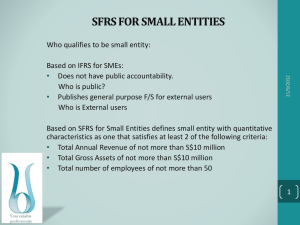
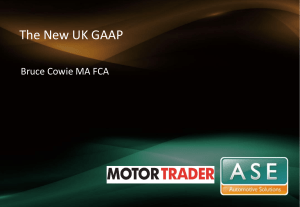
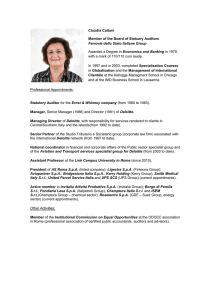

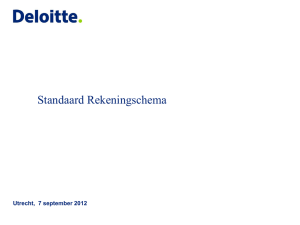
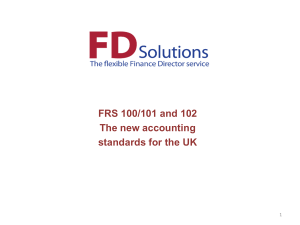


![South east presentation resources [pdf, 7.8MB]](http://s2.studylib.net/store/data/005225551_1-572ef1fc8a3b867845768d2e9683ea31-300x300.png)

